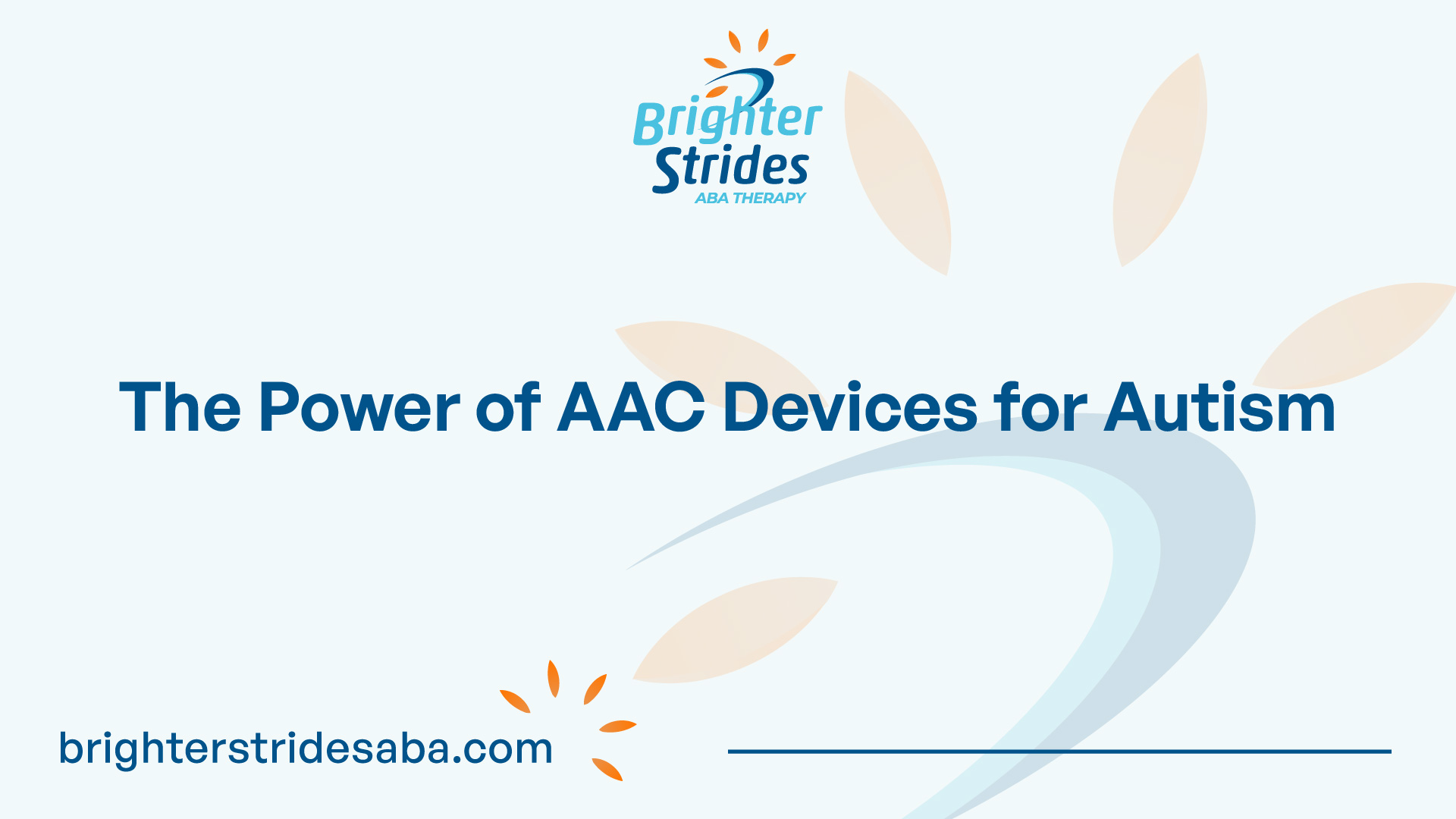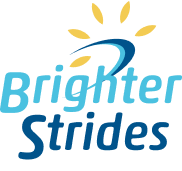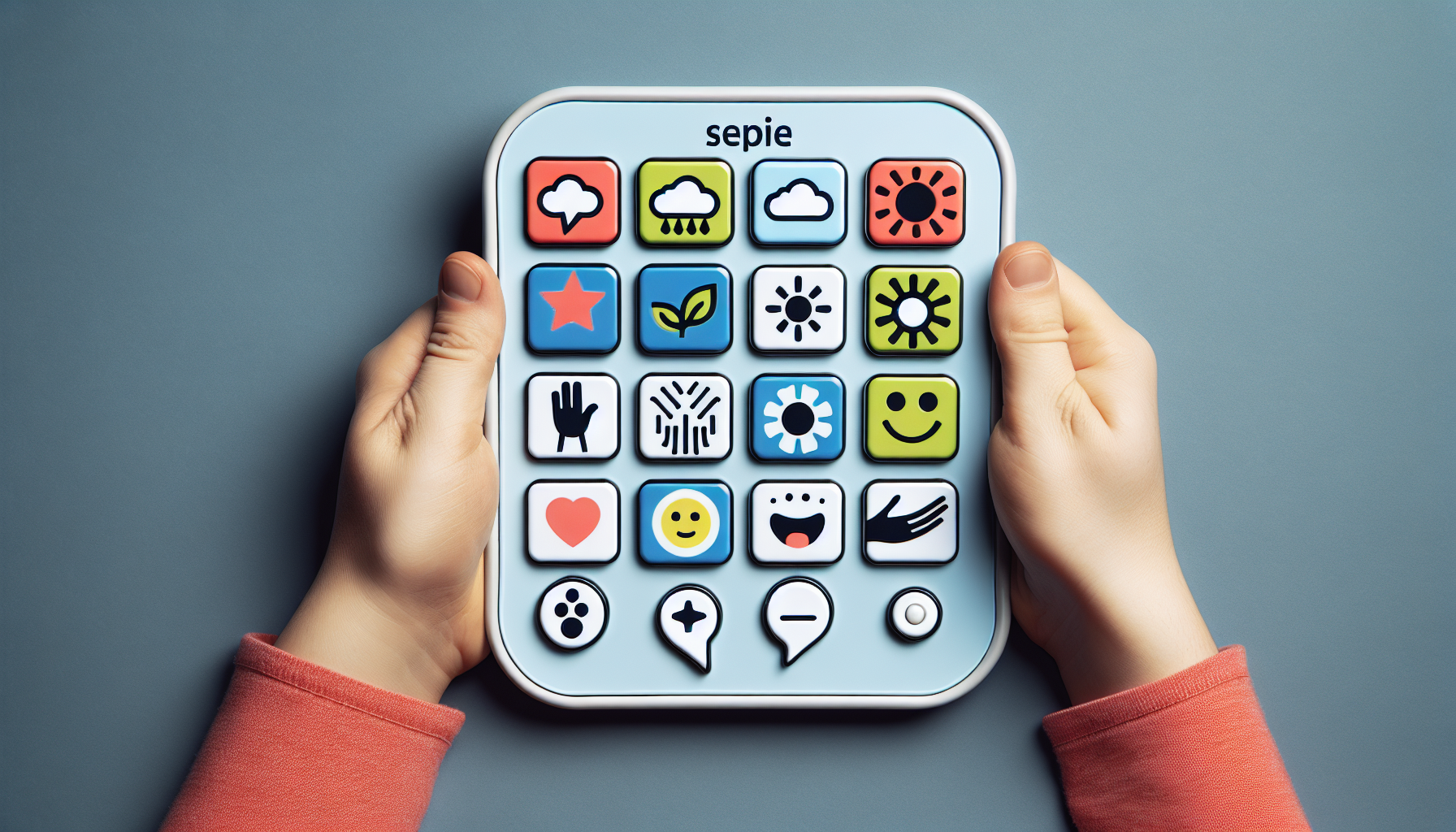Understanding AAC Devices
Augmentative and alternative communication (AAC) is a specific type of assistive technology that provides a means of effective communication to individuals with autism spectrum disorder (ASD) who are unable to use conventional speech effectively. AAC devices can benefit people with autism of all ages by promoting independence, expanding communication, and increasing social interactions.

What is AAC?
AAC encompasses all the ways that individuals communicate besides talking and can be used by people of all ages who have trouble with speech or language skills. It provides a means for individuals to express their thoughts, ideas, and needs using various methods such as gestures, sign language, picture symbols, and speech-generating devices.
AAC devices, also known as voice output communication devices, have been used for many years to help individuals with developmental and acquired disabilities communicate successfully. These devices enable nonverbal individuals with autism to overcome their communication barriers and effectively express themselves.
Benefits of AAC Devices
AAC devices play a crucial role in the lives of individuals with autism by providing them with a means to communicate independently and effectively. Here are some key benefits of using AAC devices:
- Promotes Communication: AAC devices enable individuals with autism to express their thoughts, needs, and emotions, facilitating meaningful interactions with others. This promotes social engagement and enhances overall communication skills.
- Expands Vocabulary: AAC systems offer a wide range of language options, allowing individuals to access and use a variety of words and phrases. This supports vocabulary development and language learning, enhancing overall language skills.
- Enhances Speech Development: Research has shown that providing AAC systems to individuals with autism does not inhibit the development of verbal speech. In fact, AAC systems can enhance verbal speech by providing an active means of communication that encourages the learning and combining of words to form phrases and sentences. The auditory output of AAC devices also aids in the development of language skills.
- Supports Independence: AAC devices give individuals with autism the ability to communicate their wants, needs, and choices independently, reducing frustration and promoting self-confidence and autonomy.
- Improves Social Interactions: By facilitating communication, AAC devices enable individuals with autism to actively participate in social interactions, fostering connections with peers, family, and the broader community.
AAC devices are customizable to meet the unique needs of individuals with autism, providing a powerful tool that enhances communication and enriches lives. Whether through low-tech options, mid-tech devices, or high-tech solutions, AAC devices offer a pathway to inclusive communication and increased independence.
AAC for Autism
For individuals with autism spectrum disorder (ASD) who struggle with conventional speech, augmentative and alternative communication (AAC) devices provide a means of effective communication. AAC is a specific type of assistive technology that can benefit people with autism of all ages by promoting independence, expanding communication, and increasing social interactions.
AAC devices are designed to support and enhance communication for individuals with autism, regardless of their speech ability. These devices can be utilized by people of all ages who have difficulty with speech or language skills. AAC encompasses all the ways someone communicates besides talking and can be used temporarily or throughout one’s life.
Impact of AAC on Speech Development
Contrary to common misconceptions, research has shown that providing an AAC system to a child does not inhibit the development of verbal speech. In fact, AAC systems can enhance verbal speech by providing an active means of communication that encourages the learning and combining of words to form phrases and sentences. The auditory output of AAC devices also aids in the development of language skills [3].
AAC devices offer individuals a way to express themselves and engage in meaningful communication. By using AAC, individuals with autism can develop their language skills, improve their ability to interact with others, and potentially reduce frustration and anxiety associated with communication difficulties. These devices provide a supportive and adaptable platform for individuals to express their thoughts, needs, and desires.
It is important to note that AAC devices are not a replacement for the development of verbal speech. Rather, they serve as a supplement and support individuals in their communication journey. AAC devices provide a bridge between nonverbal or minimally verbal individuals with autism and the world around them, enabling them to participate more fully in social interactions and educational settings.
By embracing AAC devices, individuals with autism can experience transformative benefits in their ability to communicate, engage with others, and navigate the world around them. These devices play a vital role in empowering individuals with autism and providing them with the tools they need to express themselves effectively.
Types of AAC Devices
When it comes to augmentative and alternative communication (AAC) devices for individuals with autism, there are various options available to support their communication needs. These devices range from low-tech options to high-tech devices, each offering unique features and benefits. Let’s explore the different types of AAC devices:
Low-Tech AAC Options
Low-tech AAC options are simple and cost-effective communication tools that do not require electronic components. These options can include:
- Pictures and Symbols: Using pictures or symbols on communication boards or books, individuals can point to or select the appropriate image to convey their message. This method is particularly helpful for individuals who have difficulty with fine motor skills or prefer visual communication.
- Gestures and Sign Language: Gestures, such as pointing or using basic sign language, can be used as a form of AAC. Simple gestures and signs can help individuals express their needs and interact with others.
Low-tech AAC options are accessible and can be easily customized to meet the individual’s specific communication requirements. However, they may have limitations in terms of vocabulary and flexibility compared to higher-tech options.
Mid-Tech AAC Devices
Mid-tech AAC devices bridge the gap between low-tech and high-tech options. These devices often provide speech output and may have limited customization features. Some examples of mid-tech AAC devices include:
- Speech-Output Devices: These devices allow individuals to select pre-recorded messages or sentences, which are then spoken aloud by the device. They can be particularly useful for individuals who have challenges with motor skills or require a more comprehensive vocabulary.
Mid-tech AAC devices offer a more dynamic and interactive means of communication compared to low-tech options. However, they may have limitations in terms of customization and adaptability.
High-Tech AAC Devices
High-tech AAC devices utilize advanced technology to provide a wide range of communication features and customization options. These devices often have touch screens, voice output, and may even support text-based communication. Some high-tech AAC devices include:
- Tablets and Smartphones: With the use of AAC-specific apps, tablets and smartphones can transform into powerful AAC devices. These devices offer a variety of communication methods, including symbol-based, text-based, or multimodal options. They can be highly customizable and provide access to a vast library of vocabulary and communication tools.
- Dedicated AAC Devices: These devices are specifically designed for AAC purposes and often come with dedicated software and features. They may have touch screens, customizable layouts, and additional accessibility features to cater to different communication needs.
High-tech AAC devices offer extensive customization options, advanced communication capabilities, and the ability to grow with the individual’s communication skills. However, they can be more expensive and may require additional training and support for effective use.
When determining the most suitable AAC system for an individual with autism, it is essential to involve an AAC evaluation team. This team, which may include speech-language pathologists and other specialists, can assess the individual’s specific needs and recommend the appropriate AAC device based on their communication abilities, preferences, and goals.
By understanding the various types of AAC devices available, individuals with autism can find the communication tool that best supports their unique needs, empowering them to express themselves and engage more effectively with the world around them.
Using AAC Devices
When it comes to using Augmentative and Alternative Communication (AAC) devices, teaching individuals with autism how to effectively use these devices is crucial. By providing the appropriate support and guidance, individuals can harness the power of AAC devices to enhance their communication skills and connect with others. This section will delve into the process of teaching AAC device usage and the customization options available.
Teaching AAC Device Usage
Teaching a child with autism to use AAC devices involves several key steps. The first step is modeling the use of the device, where a communication partner demonstrates how the AAC device is used to express messages. This modeling helps the child understand the purpose and functionality of the device [4].
Next, the AAC device is offered to the child, allowing them to explore and interact with it. Assistance may be provided initially to help the child navigate and use the device effectively. Over time, the level of prompting is gradually faded, empowering the child to independently use the AAC device to communicate their needs and desires.
As the child progresses, it is important to introduce new words and phrases on the AAC device, expanding their vocabulary and promoting language development. By continually adding new words, the child’s ability to express themselves and engage in meaningful conversations can greatly improve.
AAC Device Customization
AAC devices for individuals with autism come in different types, ranging from low-tech options like gestures, sign language, and pictures to high-tech devices with touch screens and customization options. The choice of AAC system should be determined through an AAC evaluation conducted by a specialized team.
Customization plays a vital role in maximizing the effectiveness of AAC devices. These devices can be personalized to cater to the unique communication needs and preferences of each individual. Customization options may include selecting appropriate symbols, images, or icons that resonate with the user, adjusting the device layout, or adding specific phrases or vocabulary relevant to the user’s daily life.
By customizing AAC devices, individuals with autism can have a more personalized and meaningful communication experience. This customization helps to ensure that the AAC system aligns with their individual communication abilities and fosters successful communication exchanges.
Through proper teaching and customization, AAC devices can empower individuals with autism to effectively express their thoughts, needs, and desires. These devices serve as a valuable tool in giving a voice to non-verbal children with autism, facilitating communication and building trust with the world around them.
Obtaining AAC Devices
When it comes to accessing AAC devices for individuals with autism, there are a few different options available. This section will explore how to access AAC devices and the cost and insurance coverage associated with them.
How to Access AAC Devices
AAC devices can be obtained through a few different avenues. One option is to purchase an iPad or tablet and download the AAC app yourself. Many AAC apps are available for download, offering a range of features and functionalities. This allows you to have immediate access to the AAC device and customize it according to your needs and preferences.
Another way to access AAC devices is through your child’s doctor. In the United States, most health insurances cover the cost of AAC devices, making it more accessible to families. By working with your child’s doctor, you can determine the most suitable AAC device and ensure that it is covered by your insurance.
When considering AAC apps, it’s worth noting that some apps offer sales twice a year, typically in April and October, with discounts of up to 50%. AssistiveWare’s Proloquo is one example of an AAC app that offers discounts during these sale periods. Additionally, some apps provide a free trial period, allowing you to try out the app before making a purchase.
Cost and Insurance Coverage
The cost of AAC devices can vary depending on the type and features of the device. For robust AAC apps that offer comprehensive features and functionalities, prices typically range from $100 to $300. However, it’s important to note that prices can differ among different AAC apps. It’s recommended to research and compare various options to find the one that best suits your needs and budget.
Fortunately, in the United States, most health insurances cover the cost of AAC devices. This coverage helps make AAC devices more accessible to individuals with autism. It’s advisable to consult with your insurance provider to understand the specific coverage details and requirements. By working closely with your child’s doctor and insurance provider, you can navigate the process of obtaining an AAC device more seamlessly.
In an educational setting, obtaining an AAC device can be facilitated through an assistive technology assessment. If your child has an Individualized Education Program (IEP), requesting an assessment can help ensure that the AAC device is included in the plan. This ensures continuous access to the device at school, supporting your child’s communication needs [5].
By understanding how to access AAC devices and the cost and insurance coverage associated with them, you can take the necessary steps to provide individuals with autism the communication support they need. AAC devices have the power to transform lives by enhancing communication abilities and promoting independence.
AAC in Educational Settings
In educational settings, AAC (Augmentative and Alternative Communication) devices play a crucial role in supporting individuals with autism. These devices can be integrated into the Individualized Education Programs (IEPs) and are supported by speech-language pathologists (SLPs) who play a vital role in their implementation.
AAC in Individualized Education Programs (IEPs)
For children with autism who have an Individualized Education Program (IEP), obtaining AAC devices can be facilitated by requesting an assistive technology assessment. This assessment helps ensure continuous access to the device at school, as it will be included in the IEP. By incorporating AAC devices into the IEP, educational teams can provide the necessary support and accommodations for the child’s communication needs.
Including AAC devices in the IEP ensures that the child has access to the device during school hours and that teachers and support staff are trained in its use. This integration allows for consistent use and promotes communication independence for individuals with autism. The IEP team, including parents, educators, and SLPs, collaborates to determine the appropriate AAC goals and strategies to support the child’s communication development.
Role of Speech-Language Pathologists
Speech-language pathologists (SLPs) play a central role in the implementation of AAC devices for individuals with autism. They possess the expertise and knowledge to assess, diagnose, and provide intervention for individuals who require AAC support. SLPs are involved in various professional roles and activities, including clinical and educational services, advocacy, education, administration, and research.
In an educational setting, SLPs collaborate with the IEP team to determine the most appropriate AAC device and strategies for the individual with autism. They conduct assessments to gather information about the individual’s communication abilities and needs, and then design and implement AAC interventions tailored to the individual’s specific requirements.
SLPs also provide training and support to the educational team, including teachers and parents, ensuring that everyone involved is equipped with the knowledge and skills to facilitate effective AAC device use. They monitor progress, make adjustments as necessary, and provide ongoing support to maximize the individual’s communication potential.
By working closely with the IEP team and serving as a resource for AAC devices, SLPs play a critical role in enhancing the educational experience and communication outcomes for individuals with autism.
In educational settings, AAC devices integrated into IEPs and supported by SLPs enable individuals with autism to communicate effectively, participate in classroom activities, and access educational opportunities. The collaboration between the IEP team and SLPs ensures that AAC devices are appropriately implemented, leading to improved communication skills and overall educational success for individuals with autism.
References
- https://pubmed.ncbi.nlm.nih.gov/25995080/
- https://www.autismspeaks.org/technology-and-autism
- https://www.aacandautism.com/about/why-aac
- https://www.speechandlanguagekids.com/giving-voice-non-verbal-children-autism-aac-autism/
- https://notanautismmom.com/2021/09/20/aac-devices-what-they-are-and-how-you-can-get-one-for-your-autistic-child/
- https://www.asha.org/practice-portal/professional-issues/augmentative-and-alternative-communication/

 We've just released an article!
Check out our blog!
We've just released an article!
Check out our blog!



